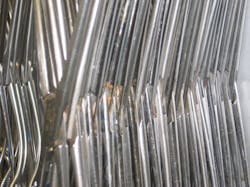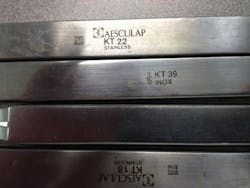Understanding your P’s, Q’s, and S’s in instrument care & handling
Q:
I have been asked to, “Explain the difference between polishing and passivation,” and, “Explain the difference about spotting and staining on instruments.” I will tie both answers together because, in my mind, they go hand-in-hand when it comes to care and handling of surgical instruments.
A:
In my observation, approximately 75% or more of the surgical instruments available today in a medical device reprocessing department are made of stainless steel, which in most respects is an ideal material. It resists rust, takes a fine point, and retains an edge. But the term "stainless" is frequently, to me, taken too literally. Stainless steel does have its weaknesses—water spotting and staining are but two. So, there is no "stainless" type of steel.
During manufacturing, surgical instruments undergo many processes Two of which, we will focus, that help to inhibit the tendency to corrode are passivation and polishing.
Passivation is a chemical process. It should remove all iron particles, leaving a corrosion resistant-surface by forming a thin-transparent oxide film. Passivation subjects the instrument to a solution of dilute acid and oxidizing salts.
Polishing achieves a smooth, closed-surface and builds up a protective outer layer of chromium oxide. This oxidized layer is highly resistant to corrosion and continues to build up with regular use and sterilization. Remember, on the other hand, this protective coating could be unknowingly removed if the instruments are cleaned improperly (i.e., exposed to harsh cleaning solutions and brushed with highly abrasive materials). Also, etching instruments will ruin the coating and promote corrosion.
Another P, medical device reprocessing professionals should be aware of, is Pitting of the medical devices. Pitting can be caused by exposure to blood, chloride, or other highly corrosive solutions. It occurs in shallow to deep, localized defects that appear as black holes (pits) on the instrument's surface. Some say you can't repair this defect. What you must do is remove pitted instruments from the set and replace them, and work with your repair company to find the causes.
Staining is a discoloration of the stainless-steel surface. Some stains disappear when the cause is removed or understood. Others may be permanent until the device is refurbished by the original manufacturer of the device or an authorized dealer like a repair company. Some can never be refurbished, the damage is too far gone, once noticed.
I have been talking about stainless-steel instruments, and, as I stated earlier, they represent at least 75% of a department’s instruments inventory. I want to stress that medical device reprocessing professionals need to understand all the various materials and how they are processed. One material is titanium. This is what one company states about the color on their instruments. “Different shades of blue may be found on our various anodized xxxx Titanium instrumentation. This is not a defect but a phenomenon, which can occur due to any slight variation of manufacturing technique or alloy composition. This is a cosmetic characteristic only and does not compromise the high-quality of your xxxx Titanium Instrumentation.” This statement shows the importance of reviewing the instructions for use (IFU) of all devices.
Many device manufacturers have charts within their instrument catalog explaining causes and solutions to common staining and spotting. If you use a repair company, they also have resources to help solve these issues.
My experience has shown me that many of the staining and spotting problems are due to such factors as a) water pH, b) boiler compounds in water lines, c) cleaning solution residue, d) laundry residue from cloth towels/wrappers, e) exposure to chemicals incompatible with the surgical instrument material, and f) automatic washers not being tested properly with clinically relevant evidence-based products , to name a few of the reasons.
Taking care of one of the medical facility’s greatest investment medical devices used in surgery (surgical instruments), understanding these terms, and working with your various manufacturers is important to make them last as long as possible. Staff needs to remember “inspect to prevent” at each stage of the medical device reprocessing cycle. And if an issue find out the “why” to prevent it from taking place again.
About the Author

Stephen M. Kovach
Stephen M Kovach, BS, CFER, started in the medical field in 1975 as a sterilization orderly and has worked in many positions within the Healthcare Industry. He presently is Clinical Educator Emeritus at Healthmark, A Getinge company.


